Ecological Restoration and Protection of National Land Space in Coal Resource-Based Cities from the Perspective of Ecological Security Pattern: A Case Study in Huaibei City, China
Abstract
1. Introduction
2. Study Aera and Data Sources
2.1. Study Aera
2.2. Data Sources
3. Methodology
3.1. Identifying Ecological Sources with Ecosystem “Function-Structure” Conceptual Framework
3.1.1. Developing Ecosystem ‘Function-Structure’ Conceptual Framework
| Ecosystem Service Functions | Method | Formula and Variable Description |
|---|---|---|
| Habitat Quality (HQ) | InVEST habitat quality model | : habitat quality of raster in land use type ; : the habitat suitability of land use type ; : total threat level of raster in land use type ; : a scaling parameter and is 2.5 in this paper; : a half-saturation constant, typically assigned a value of 0.5. |
| Water Yield (WY) | InVEST Annual Water Yield model | : water yield of raster in land use type ; : annual average precipitation of raster ; : evapotranspiration of raster in land use type . |
| Soil Conservation (SC) | modified universal soil loss equation (RUSLE) | : the amount of soil conservation (t/hm2·a); : the factor of rainfall erosivity (MJ·mm/hm2·h·a); :factor of soil erodibility (t·hm2·h/hm2·MJ·mm); and : are the topographic factors, this paper uses topographic relief to calculate. |
| Carbon Sequestration (CS) | InVEST carbon storage and sequestration model | : the total amount of carbon storage; : above-ground biomass carbon stocks; : below-ground biomass carbon stocks; : soil carbon stocks; : dead organic matter carbon stocks. The biomass carbon density for the different land-use types was derived from the results of a relevant study [60]. |
3.1.2. Identifying Ecological Sources
3.2. Revising Ecological Resistance Surface Using “Coal Mining Subsidence—Economic Activities” Framework
3.3. Extracting Ecological Corridors and Constructing Esp Based on Circuit Theory
3.4. Identifying Key Areas for Ecological Restoration and Protection
3.4.1. Identifying Ecological Pinch Points
3.4.2. Identifying Ecological Barrier Points
3.4.3. Identifying Ecological Fracture Points
4. Result
4.1. Ecological Sources
4.1.1. Results of Ecosystem Function
4.1.2. Results of Ecosystem Structure
4.1.3. Identifying Ecological Sources
4.2. Ecological Resistance Surface
4.3. Ecological Corridors
4.4. Ecological Security Pattern
4.5. Key Areas for Ecological Restoration and Protection
4.5.1. Identifying Ecological Pinch Points
4.5.2. Identifying Ecological Barrier Points
4.5.3. Identifying Ecological Fracture Points
5. Discussion
5.1. Pattern of Ecological Restoration and Protection
5.2. Ecological Restoration and Protection Strategies for Key Areas
5.3. Limitations and Future Work
6. Conclusions
Author Contributions
Funding
Data Availability Statement
Acknowledgments
Conflicts of Interest
References
- Wen, B.; Pan, Y.H.; Zhang, Y.Y.; Liu, J.J.; Xia, M. Does the Exhaustion of Resources Drive Land Use Changes? Evidence from the Influence of Coal Resources-Exhaustion on Coal Resources-Based Industry Land Use Changes. Sustainability 2018, 10, 2698. [Google Scholar] [CrossRef]
- Ruan, F.L.; Yan, L.; Wang, D. The complexity for the resource-based cities in China on creating sustainable development. Cities 2020, 97, 102571. [Google Scholar] [CrossRef]
- Harnischmacher, S.; Zepp, H. Mining and its impact on the earth surface in the Ruhr District (Germany). Z. Für Geomorphol. 2014, 58, 3–22. [Google Scholar] [CrossRef]
- Guan, J.; Yu, P. Does Coal Mining Have Effects on Land Use Changes in a Coal Resource-Based City? Evidence from Huaibei City on the North China Plain. Int. J. Environ. Res. Public Health 2021, 18, 11616. [Google Scholar] [CrossRef] [PubMed]
- Guan, J.; Jiao, H.F. The evolution process and influencing factors of urban-rural spatial structure in coal resource-based city: A case study of Huaibei city in Anhui province. J. Nat. Resour. 2021, 36, 2836–2852. [Google Scholar] [CrossRef]
- Farrington, J.D. The Impact of mining activities on mongolia’s protected areas: A status report with policy recommendations. Integr. Environ. Assess. Manag. 2005, 1, 283–289. [Google Scholar] [CrossRef] [PubMed]
- Almenar, J.B.; Bolowich, A.; Elliot, T.; Geneletti, D.; Sonnemann, G.; Rugani, B. Assessing habitat loss, fragmentation and ecological connectivity in Luxembourg to support spatial planning. Landsc. Urban Plan. 2019, 189, 335–351. [Google Scholar] [CrossRef]
- Li, S.C.; Xiao, W.; Zhao, Y.L.; Lv, X.J. Incorporating ecological risk index in the multi-process MCRE model to optimize the ecological security pattern in a semi-arid area with intensive coal mining: A case study in northern China. J. Clean. Prod. 2020, 247, 119143. [Google Scholar] [CrossRef]
- Walz, R. Development of Environmental Indicator Systems: Experiences from Germany. Environ. Manag. 2000, 25, 613–623. [Google Scholar] [CrossRef]
- Cumming, G.S.; Allen, C.R. Protected areas as social-ecological systems: Perspectives from resilience and social-ecological systems theory. Ecol. Appl. 2017, 27, 1709–1717. [Google Scholar] [CrossRef]
- Martin, D.M. Ecological restoration should be redefined for the twenty-first century. Restor Ecol 2017, 25, 668–673. [Google Scholar] [CrossRef] [PubMed]
- Larondelle, N.; Haase, D. Valuing post-mining landscapes using an ecosystem services approach—An example from Germany. Ecol. Indic. 2012, 18, 567–574. [Google Scholar] [CrossRef]
- Lee, D.-K.; Mojtabai, N.; Lee, H.-B.; Song, W.-K. Assessment of the influencing factors on subsidence at abandoned coal mines in South Korea. Environ. Earth Sci. 2013, 68, 647–654. [Google Scholar] [CrossRef]
- Wirth, P.; Chang, J.; Syrbe, R.U.; Wende, W.; Hu, T.H. Green infrastructure: A planning concept for the urban transformation of former coal-mining cities. Int. J. Coal Sci. Technol. 2018, 5, 78–91. [Google Scholar] [CrossRef]
- Galanina, T.; Koroleva, T.; Zakamskaya, L.; Tretyakova, I. The land reclamation concept as a key factor in solving the environmental problems of coal mining regions. In Proceedings of the E3S Web of Conferences, Kemerovo, Russian, 1 October 2020; p. 02017. [Google Scholar]
- Akcin, H.; Kutoglu, H.S.; Kemaldere, H.; Deguchi, T.; Koksal, E. Monitoring subsidence effects in the urban area of Zonguldak Hardcoal Basin of Turkey by InSAR-GIS integration. Nat. Hazards Earth Syst. Sci. 2010, 10, 1807–1814. [Google Scholar] [CrossRef]
- Lei, K.; Pan, H.; Lin, C. A landscape approach towards ecological restoration and sustainable development of mining areas. Ecol. Eng. 2016, 90, 320–325. [Google Scholar] [CrossRef]
- Zhao, H.; Ma, F.; Zhang, Y.; Guo, J. Monitoring and mechanisms of ground deformation and ground fissures induced by cut-and-fill mining in the Jinchuan Mine 2, China. Environ. Earth Sci. 2013, 68, 1903–1911. [Google Scholar] [CrossRef]
- Palamakumbure, D.; Stirling, D.; Flentje, P.; Chowdhury, R. ArcGIS V. 10 Landslide Susceptibility Data Mining Add-in Tool Integrating Data Mining and GIS Techniques to Model Landslide Susceptibility. In Proceedings of the Engineering Geology for Society and Territory—Volume 2, Cham, switzerland, 2 September 2015; pp. 1191–1194. [Google Scholar]
- Mace, G. Global change: Ecology must evolve. Nature 2013, 503, 191–192. [Google Scholar] [CrossRef] [PubMed]
- Sasaki, T.; Furukawa, T.; Iwasaki, Y.; Seto, M.; Mori, A.S. Perspectives for ecosystem management based on ecosystem resilience and ecological thresholds against multiple and stochastic disturbances. Ecol. Indic. 2015, 57, 395–408. [Google Scholar] [CrossRef]
- Gao, M.; Hu, Y.; Bai, Y. Construction of ecological security pattern in national land space from the perspective of the community of life in mountain, water, forest, field, lake and grass: A case study in Guangxi Hechi, China. Ecol. Indic. 2022, 139, 108867. [Google Scholar] [CrossRef]
- Silva, A.M.d.; Bortoleto, L.A.; Castelli, K.R.; Silva, R.A.E.; Mendes, P.B. Prospecting the potential of ecosystem restoration: A proposed framework and a case study. Ecol. Eng. 2017, 108, 505–513. [Google Scholar] [CrossRef]
- Yu, K. Security patterns and surface model in landscape ecological planning. Landsc. Urban Plan. 1996, 36, 1–17. [Google Scholar] [CrossRef]
- Fang, Y.; Wang, J.; Huang, L.Y.; Zhai, T.L. Determining and identifying key areas of ecosystempreservation and restoration for territorial spatial planning based on ecological security patterns: A case study of Yantai city. J. Nat. Resour. 2020, 35, 190. [Google Scholar]
- Peng, J.; Yang, Y.; Liu, Y.-x.; Hu, Y.n.; Du, Y.; Meersmans, J.; Qiu, S. Linking ecosystem services and circuit theory to identify ecological security patterns. Sci. Total Environ. 2018, 644, 781–790. [Google Scholar] [CrossRef] [PubMed]
- Peng, J.; Zhao, H.J.; Liu, Y.X.; Wu, J.S. Research progress and prospect on regional ecological security pattern construction. Geogr. Res. 2017, 36, 407–419. [Google Scholar]
- Fu, Y.; Shi, X.; He, J.; Yuan, Y.; Qu, L. Identification and optimization strategy of county ecological security pattern: A case study in the Loess Plateau, China. Ecol. Indic. 2020, 112, 106030. [Google Scholar] [CrossRef]
- Aminzadeh, B.; Khansefid, M. A case study of urban ecological networks and a sustainable city: Tehran’s metropolitan area. Urban Ecosyst. 2010, 13, 23–36. [Google Scholar] [CrossRef]
- Kong, F.; Yin, H.; Nakagoshi, N.; Zong, Y. Urban green space network development for biodiversity conservation: Identification based on graph theory and gravity modeling. Landsc. Urban Plan. 2010, 95, 16–27. [Google Scholar] [CrossRef]
- Yuan, Y.; Bai, Z.K.; Shi, X.Y.; Zhao, X.J.; Zhang, J.N.; Yang, B.Y. Determining priority areas for ecosystem preservation and restoration of territory based on ecological security pattern:A case study in Zunhua City, Hebei Province. Chin. J. Ecol. 2022, 41, 750–759. [Google Scholar]
- Jiao, S.; Liu, Y.C.; Han, Z.W.; Zhou, K.J.; Hu, L.; Liu, T.X. Determining priority areas for land ecological restoration based on ecological network-human disturbance: A case study of Changsha-Zhuzhou-Xiangtan Urban Agglomeration. J. Nat. Resour. 2021, 36, 2294–2307. [Google Scholar] [CrossRef]
- Peng, J.; Pan, Y.J.; Liu, Y.X.; Zhao, H.J.; Wang, Y.L. Linking ecological degradation risk to identify ecological security patterns in a rapidly urbanizing landscape. Habitat Int. 2018, 71, 110–124. [Google Scholar] [CrossRef]
- Li, S.; Zhao, Y.; Xiao, W.; Yue, W.; Wu, T. Optimizing ecological security pattern in the coal resource-based city: A case study in Shuozhou City, China. Ecol. Indic. 2021, 130, 108026. [Google Scholar] [CrossRef]
- Zhang, X.P.; Hu, Z.H.; Wei, X.J.; Huang, Y.W. Study on Identification of Key Areas for Ecological Protection and Restoration in Resource-exhausted Region: Take Dayu County, Jiangxi as an Example. J. Ecol. Rural Environ. 2021, 37, 1031–1040. [Google Scholar]
- Yang, R.R.; Bai, Z.; Shi, Z. Linking Morphological Spatial Pattern Analysis and Circuit Theory to Identify Ecological Security Pattern in the Loess Plateau: Taking Shuozhou City as an Example. Land 2021, 10, 907. [Google Scholar] [CrossRef]
- Fan, X.; Cheng, Y.; Tan, F.; Zhao, T. Construction and Optimization of the Ecological Security Pattern in Liyang, China. Land 2022, 11, 1641. [Google Scholar] [CrossRef]
- Li, J.; Xu, J.; Chu, J.L. The Construction of a Regional Ecological Security Pattern Based on Circuit Theory. Sustainability 2019, 11, 6343. [Google Scholar] [CrossRef]
- Liu, Y.; Cui, N.; Han, R.; Guo, L. Establishing Ecological Security Patterns Based on Reconstructed Ecosystem Services Value in Rapidly Urbanizing Areas: A Case Study in Zhuhai City, China. Sustainability 2020, 12, 6629. [Google Scholar] [CrossRef]
- Wang, Y.; Pan, J. Building ecological security patterns based on ecosystem services value reconstruction in an arid inland basin: A case study in Ganzhou District, NW China. J. Clean. Prod. 2019, 241, 118337. [Google Scholar] [CrossRef]
- Zhang, L.Q.; Peng, J.; Liu, Y.X.; Wu, J.S. Coupling ecosystem services supply and human ecological demand to identify landscape ecological security pattern: A case study in Beijing–Tianjin–Hebei region, China. Urban Ecosyst. 2017, 20, 701–714. [Google Scholar] [CrossRef]
- Ran, Y.; Lei, D.; Li, J.; Gao, L.; Mo, J.; Liu, X. Identification of crucial areas of territorial ecological restoration based on ecological security pattern: A case study of the central Yunnan urban agglomeration, China. Ecol. Indic. 2022, 143, 109318. [Google Scholar] [CrossRef]
- Mcrae, B.H.; Beier, P. Circuit theory predicts gene flow in plant and animal populations. Proc. Natl. Acad. Sci. 2007, 104, 19885–19890. [Google Scholar] [CrossRef] [PubMed]
- Fang, Y.; Huang, L.Y.; Liu, S.H.; Zou, L. Construction of Wuhan’s ecological security pattern under the “quality-risk-requirement” framework. Chin. J. Appl. Ecol. 2019, 30, 615–626. [Google Scholar]
- Ge, J.S.; Han, R.Y.; Han, Y.; Luo, Z.L.; Quan, Z.J.; Shi, N.N.; Wang, Q.; Xiao, N.W. Construction and optimization of ecological network for protected areas in Qinghai Province. Chin. J. Ecol. 2018, 37, 1910–1916. [Google Scholar]
- Mcrae, B.H.; Hall, S.A.; Beier, P.; Theobald, D.M. Where to Restore Ecological Connectivity? Detecting Barriers and Quantifying Restoration Benefits. PLoS ONE 2012, 7, e52604. [Google Scholar] [CrossRef]
- Huang, J.; Hu, Y.; Zheng, F. Research on recognition and protection of ecological security patterns based on circuit theory: A case study of Jinan City. Environ. Sci. Pollut. Res. 2020, 27, 12414–12427. [Google Scholar] [CrossRef]
- Zhai, T.; Huang, L. Linking MSPA and Circuit Theory to Identify the Spatial Range of Ecological Networks and Its Priority Areas for Conservation and Restoration in Urban Agglomeration. Front. Ecol. Evol. 2022, 10, 33. [Google Scholar] [CrossRef]
- Fu, F.J.; Liu, Z.H.; Liu, H. Identifying key areas of ecosystem restoration for territorial space based on ecological security pattern: A case study in Hezhou City. Acta Ecol. Sin. 2021, 41, 3406–3414. [Google Scholar]
- Peng, J.; Zhao, S.; Dong, J.; Liu, Y.-x.; Meersmans, J.; Li, H.; Wu, J. Applying ant colony algorithm to identify ecological security patterns in megacities. Environ. Model. Softw. 2019, 117, 214–222. [Google Scholar] [CrossRef]
- Ni, Q.L.; Hou, H.P.; Ding, Z.Y.; Li, Y.B.; Li, J.R. Ecological remediation zoning of territory based on the ecological security pattern recognition: Taking Jiawang district of Xuzhou city as an example. J. Nat. Resour. 2020, 35, 204–216. [Google Scholar]
- Peng, J.; Ma, J.; Du, Y.; Zhang, L.; Hu, X. Ecological suitability evaluation for mountainous area development based on conceptual model of landscape structure, function, and dynamics. Ecol. Indic. 2016, 61, 500–511. [Google Scholar] [CrossRef]
- Peng, J.; Hu, Y.N.; Lü, H.L.; Li, T.Y.; Chen, X. Ecological function zoning based on element structure function: A case study in Dali Bai Autonomous Prefecture. Chin. J. Ecol. 2016, 35, 2251–2259. [Google Scholar]
- Li, S.C.; Liu, J.L.; Zhang, C.Y.; Zhao, Z.Q. The Research Trends of Ecosystem Services and the Paradigm in Geography. Acta Geogr. Sin. 2011, 66, 1618–1630. [Google Scholar]
- Zhao, C.; Wang, C.; Yan, Y.; Shan, P.; Li, J.; Chen, J. Ecological Security Patterns Assessment of Liao River Basin. Sustainability 2018, 10, 2401. [Google Scholar] [CrossRef]
- Li, T.S. Heterogeneity and Its Maintenance of Urban Landscape. Chin. J. Ecol. 1998, 70–72, 69. [Google Scholar]
- Wenbin, G.; Xinxiao, Y.; Yutao, Z. Review on landscape heterogeneity. Chin. J. Appl. Ecol. 2002, 13, 495–500. [Google Scholar]
- Turner, M.G. Landscape Heterogeneity and Disturbance; Springer: New York, NY, USA, 1987. [Google Scholar]
- Wu, J.; Zhang, L.; Peng, J.; Feng, Z.; Liu, H.; He, S. The integrated recognition of the source area of the urban ecological security pattern in Shenzhen. Acta Ecol. Sin. 2013, 33, 4125–4133. [Google Scholar]
- Zhao, J.; Li, C. Investigating Ecosystem Service Trade-Offs/Synergies and Their Influencing Factors in the Yangtze River Delta Region, China. Land 2022, 11, 106. [Google Scholar] [CrossRef]
- Guo, X.N.; Hu, Y.N.; Liu, Y.X.; Peng, J. Constructing ecological security patterns in mountain areas based on geological disaster sensitivity: A case study in Yuxi City, Yunnan Province, China. Chin. J. Appl. Ecol. 2017, 28, 627–635. [Google Scholar]
- Xiao, L.; Jing-hu, P. Assessment of landscape ecological security and optimization of landscape pattern based on spatial principal component analysis and resistance model in arid inland area: A case study of Ganzhou District, Zhangye City, Northwest China. Chin. J. Appl. Ecol. 2015, 26, 3126–3136. [Google Scholar]
- Keeley, A.T.H.; Beier, P.; Gagnon, J.W. Estimating landscape resistance from habitat suitability: Effects of data source and nonlinearities. Landsc. Ecol. 2016, 31, 2151–2162. [Google Scholar] [CrossRef]
- Zhu, F.; Yang, B.D.; Yang, Y.J.Z.; Shao, L.; Li, G.; Chen, F. Research on the Ecological Network Reconstruction of Traditional Mining City in East China. J. Ecol. Rural Environ. 2020, 36, 26–33. [Google Scholar]
- Pickett, S.T.A.; Cadenasso, M.L.; Rosi-Marshall, E.J.; Belt, K.T.; Groffman, P.M.; Grove, J.M.; Irwin, E.G.; Kaushal, S.S.; LaDeau, S.L.; Nilon, C.H.; et al. Dynamic heterogeneity: A framework to promote ecological integration and hypothesis generation in urban systems. Urban Ecosyst. 2017, 20, 1–14. [Google Scholar] [CrossRef]
- Guan, D.; Jiang, Y.; Cheng, L. How can the landscape ecological security pattern be quantitatively optimized and effectively evaluated? An integrated analysis with the granularity inverse method and landscape indicators. Environ. Sci. Pollut. Res. 2021, 29, 41590–41616. [Google Scholar] [CrossRef] [PubMed]
- Wang, H.H.; Li, H.T.; Xie, M.M.; Xu, M.; Li, S.L.; Bai, Z.K. Construction of ecological security pattern for systematic restoration of industrial and mining land in resource-based cities. J. Nat. Resour. 2020, 35, 162–173. [Google Scholar]
- Li, H.; Li, L.; Wu, G.S.; Zhou, Y.; Li, W.W.; Mei, Z.W. Analysis of the landscape-level connectivity of the Yunnan snub-nosed monkey habitat based on circuit theory. Acta Ecol. Sin. 2018, 38, 2221–2228. [Google Scholar]
- Liu, J.; Yin, H.W.; Kong, F.H.; Li, M.H. Structure optimization of circuit theory-based green infrastructure in Nanjing, China. Acta Ecol. Sin. 2018, 38, 4363–4372. [Google Scholar]
- Song, L.L.; Qin, M.Z. Identification of ecological corridors and its importance by integrating circuit theory. Chin. J. Appl. Ecol. 2016, 27, 3344–3352. [Google Scholar]
- Shah, V.B.; Mcrae, B.H. Circuitscape: A Tool for Landscape Ecology; SciPy: Pasadena, CA, USA, 2008. [Google Scholar]
- Mcrae, B.H.; Dickson, B.G.; Keitt, T.H.; Shah, V.B. Using circuit theory to model connectivity in ecology, evolution, and conservation. Ecology 2008, 89, 2712–2724. [Google Scholar] [CrossRef]
- Zhu, Q.; Yuan, Q.; Yu, D.P.; Zhou, W.M.; Zhou, L.; Han, Y.G.; Qi, L. Construction of ecological security network of Northeast China forest belt based on the circuit theory. Chin. J. Ecol. 2021, 40, 3463–3473. [Google Scholar]
- Tang, F.; Wang, L.; Zhang, P.T.; Fu, M.C. Construction of county-level ecological security pattern based on ecological protection red line and network in China. Trans. Chin. Soc. Agric. Eng. 2020, 36, 263–272. [Google Scholar]
- Ming, L.; Chang, J.; Li, C.; Chen, Y.; Li, C. Spatial-Temporal Patterns of Ecosystem Services Supply-Demand and Influencing Factors: A Case Study of Resource-Based Cities in the Yellow River Basin, China. Int. J. Environ. Res. Public Health 2022, 19, 16100. [Google Scholar] [CrossRef]
- Luo, Y.H.; Wang, N.; Wang, Z.Y.; Wu, J.S.; YI, T.Y.; Zhao, Y.H. Constructing an ecological security pattern in Shenzhen, China, by matching the supply and demand of ecosystem services. Chin. J. Appl. Ecol. 2022, 33, 2475–2484. [Google Scholar]
- Zhuang, Z.; Li, C.; Hsu, W.-L.; Gu, S.; Hou, X.; Zhang, C. Spatiotemporal Changes in the Supply and Demand of Ecosystem Services in China’s Huai River Basin and Their Influencing Factors. Water 2022, 14, 2559. [Google Scholar]
- Gao, J.; Du, F.; Zuo, L.; Jiang, Y. Integrating ecosystem services and rocky desertification into identification of karst ecological security pattern. Landsc. Ecol. 2021, 36, 2113–2133. [Google Scholar] [CrossRef]
- Zhu, J.; Su, J.; Yin, H.W.; Kong, F.H. Construction of Xuzhou ecological network based on comprehensive sources identification and multi-scale nesting. J. Nat. Resour. 2020, 35, 1986–2001. [Google Scholar]
- Xin, S.J.; Lian, A.H.; Liang, H.D.; Xiao, K.W.; Li, R.Y. Ecological problem identification and restoration strategy based on the mountain-water-forest-field-lake-grass-sand life community concept in Taohe River Watershed, Gannan, China. Pratacultural Sci. 2022, 39, 1256–1268. [Google Scholar]
- Balaei, B.; Wilkinson, S.; Potangaroa, R.; McFarlane, P. Investigating the technical dimension of water supply resilience to disasters. Sustain. Cities Soc. 2020, 56, 102077. [Google Scholar] [CrossRef]
- Alberti, M.; Susskind, L.E. Managing urban sustainability: An introduction to the special issue. Environ. Impact Assess. Rev. 1996, 16, 213–221. [Google Scholar] [CrossRef]
- Yuan, Y.; Bai, Z.; Zhang, J.; Xu, C. Increasing urban ecological resilience based on ecological security pattern: A case study in a resource-based city. Ecol. Eng. 2022, 175, 106486. [Google Scholar] [CrossRef]
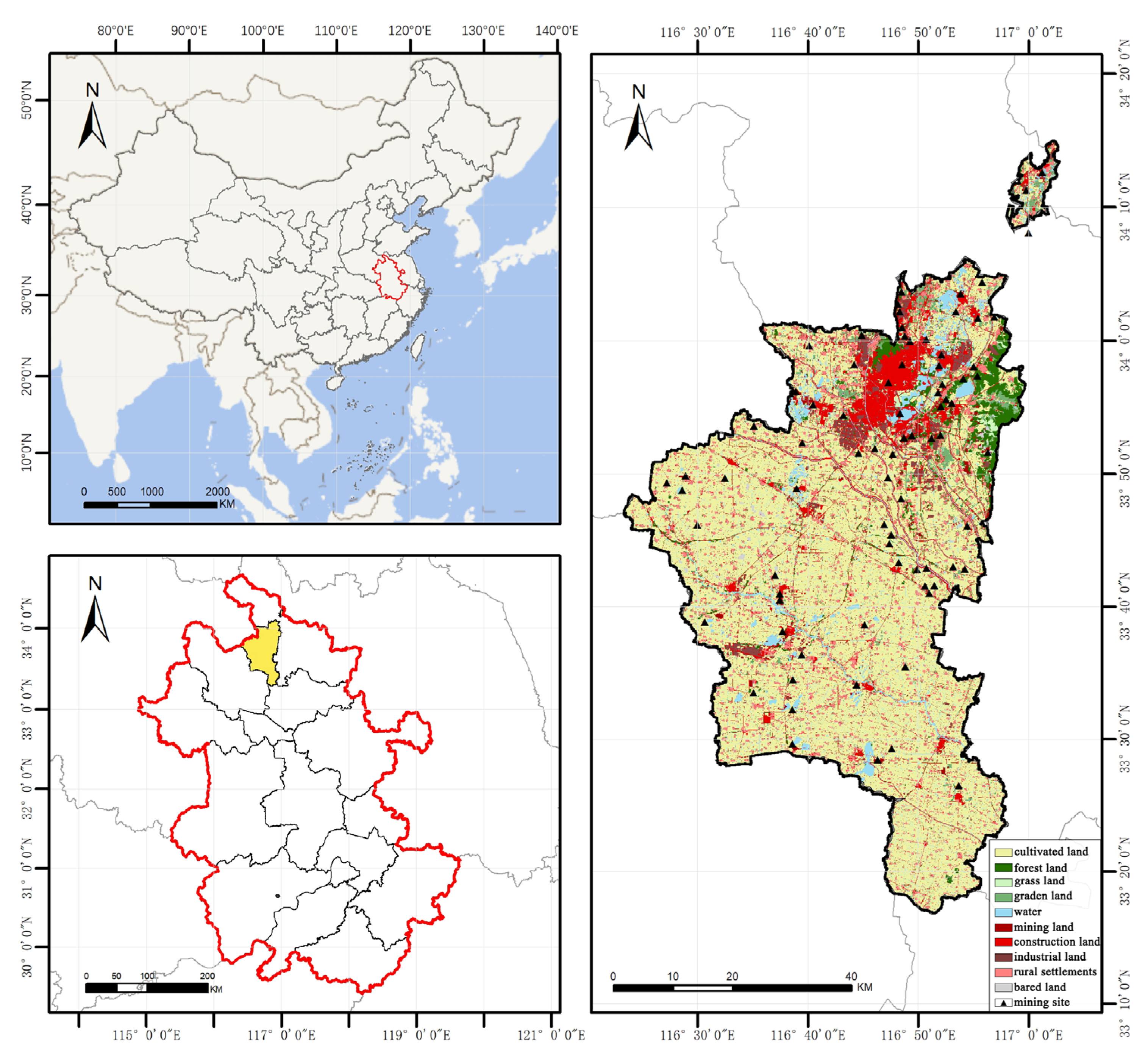
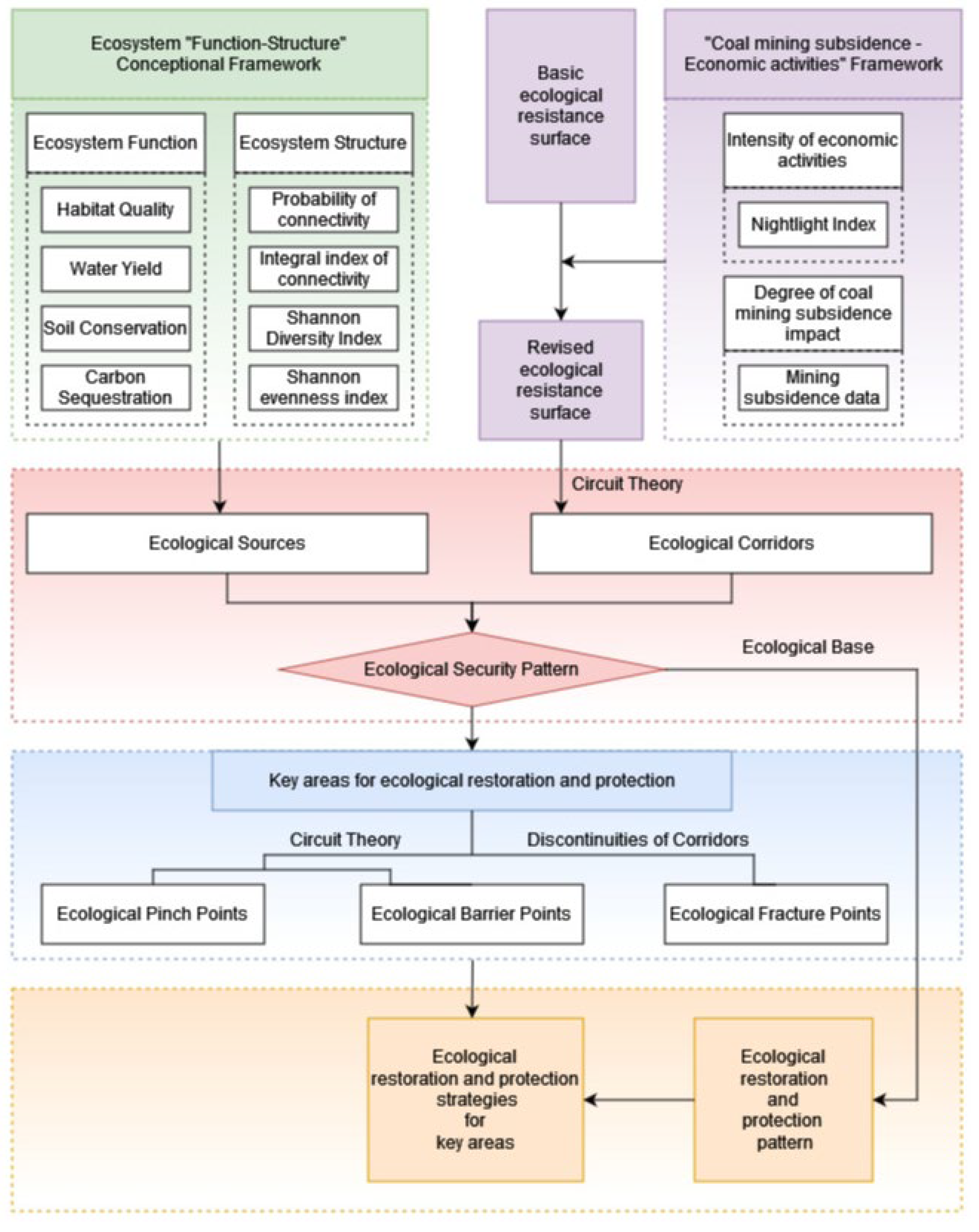
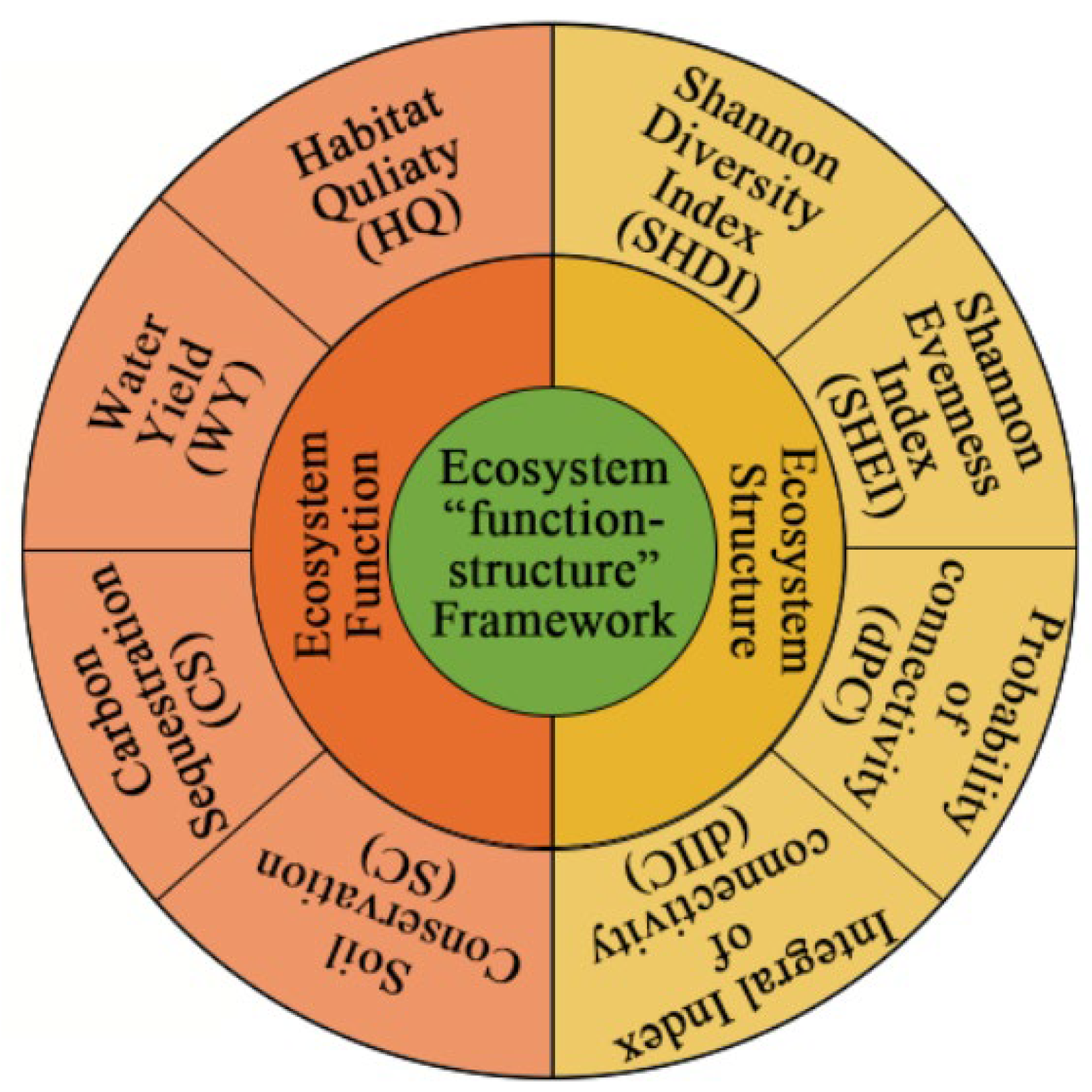
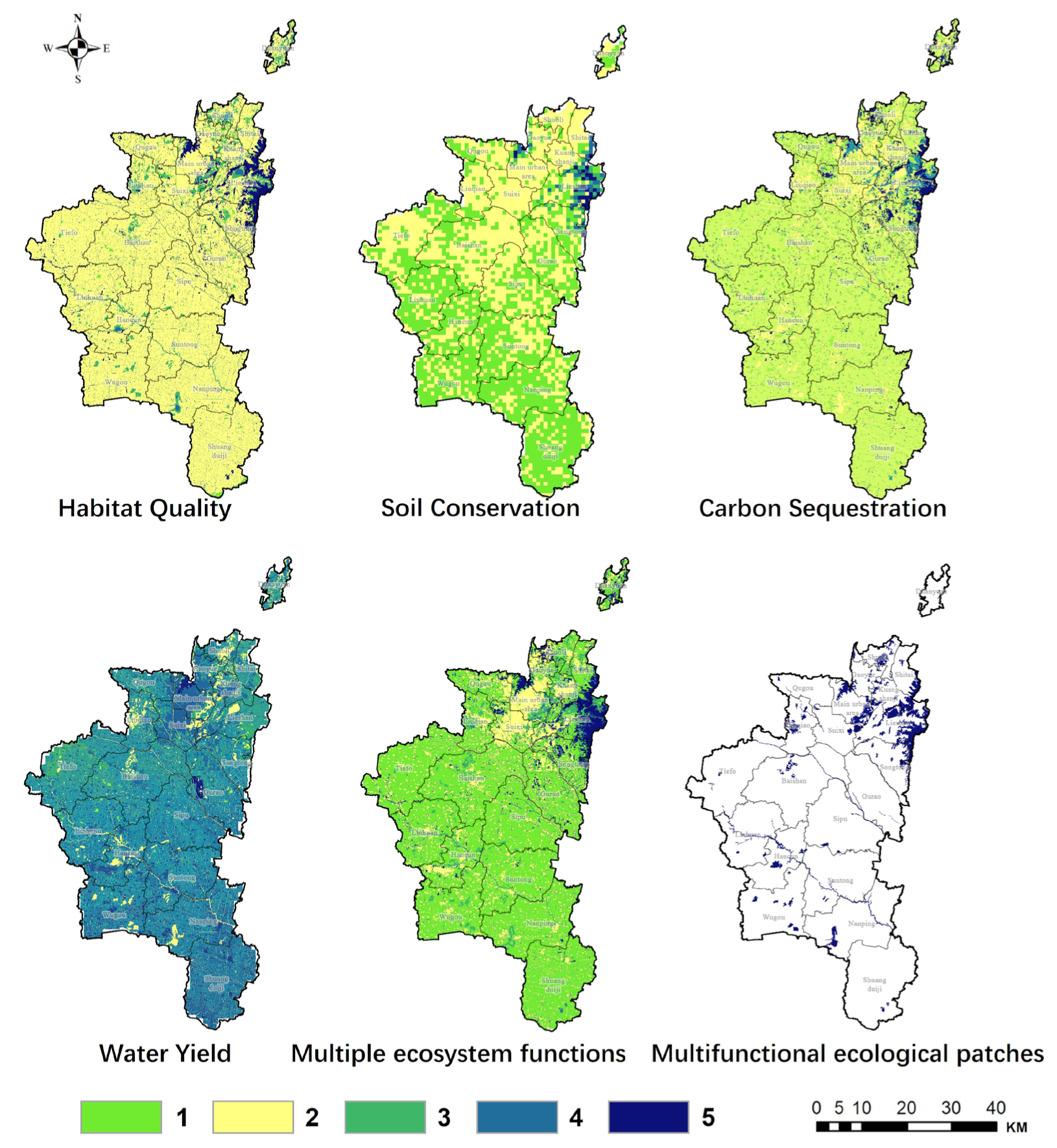

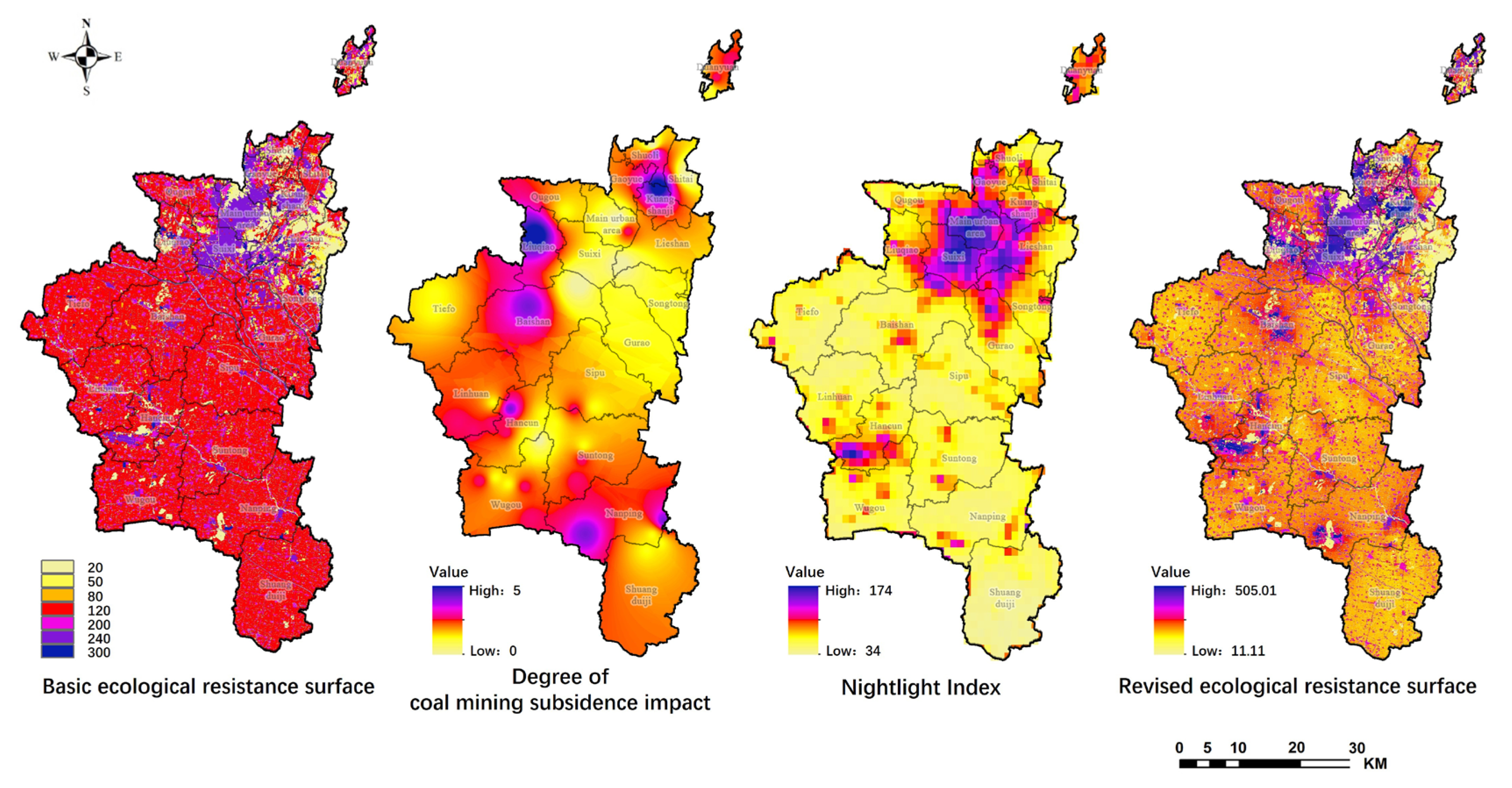
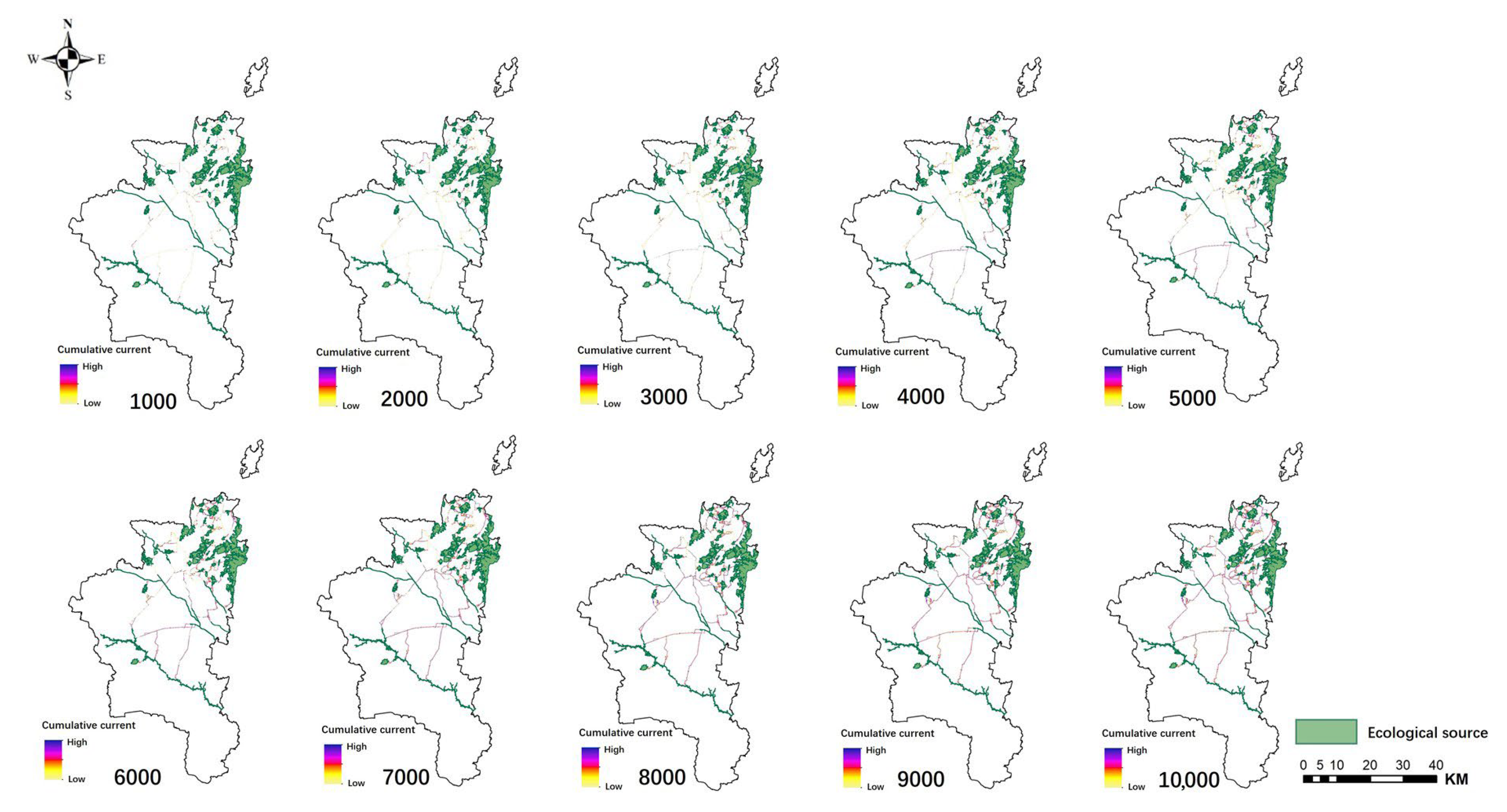
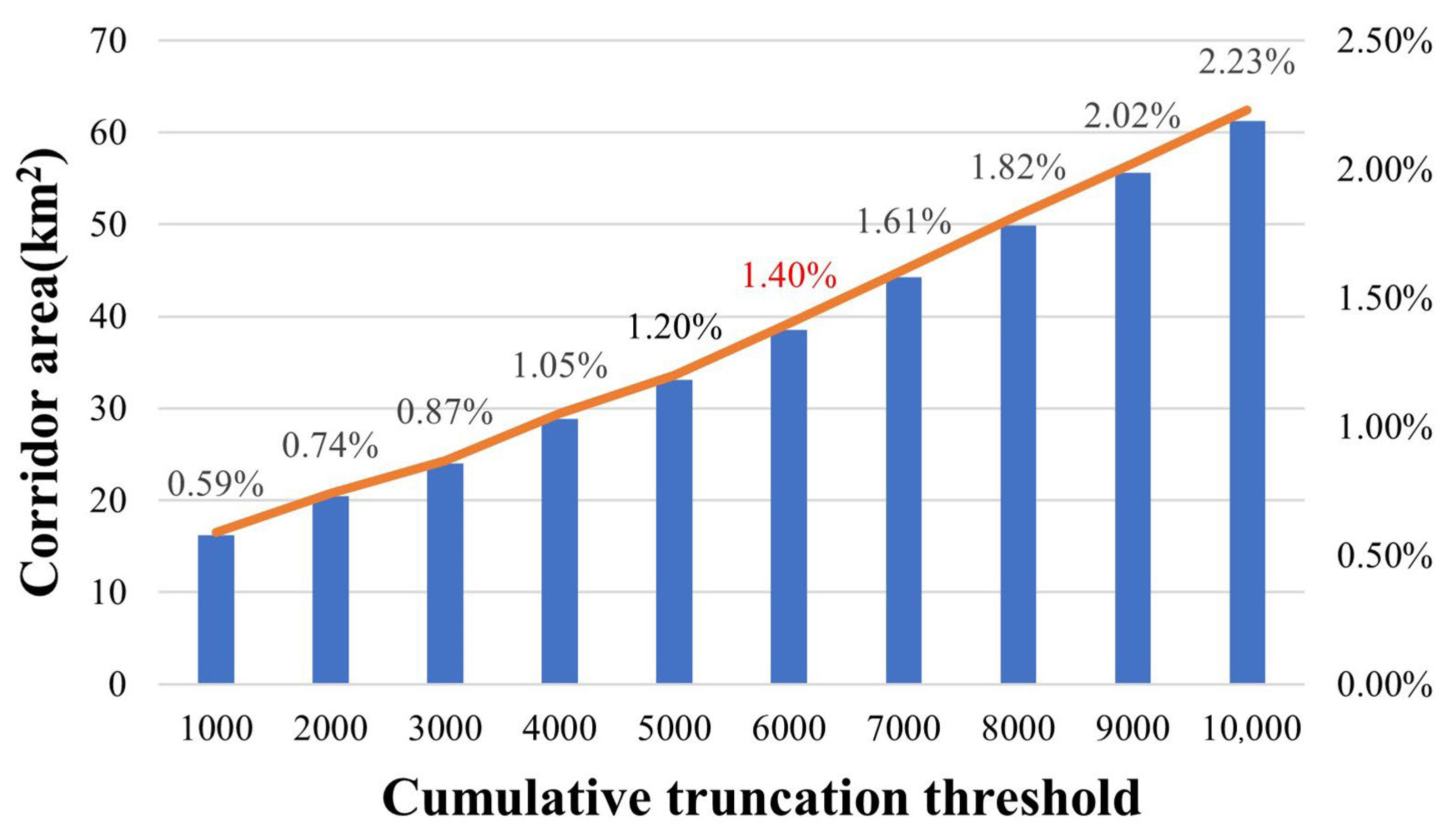



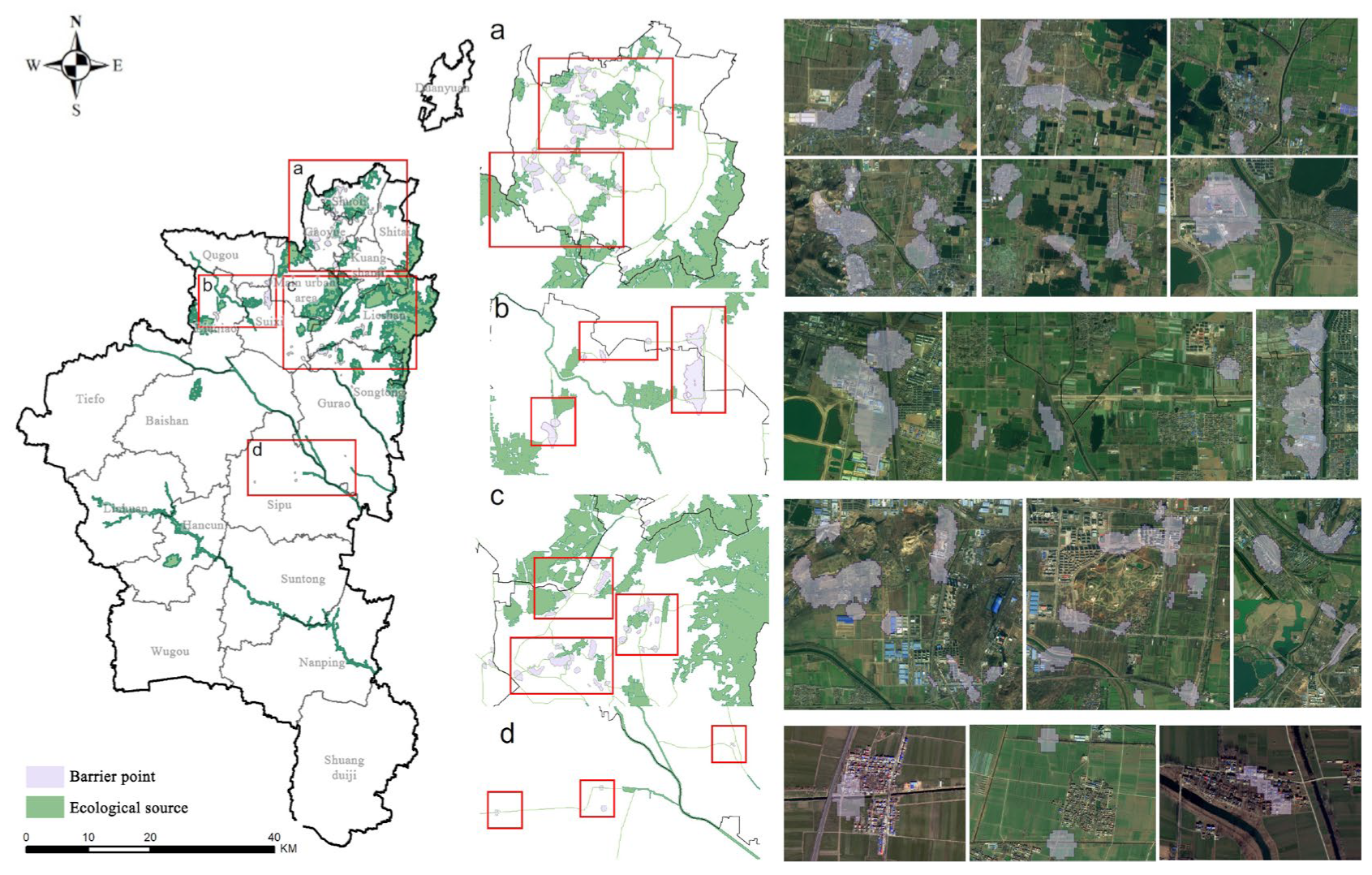
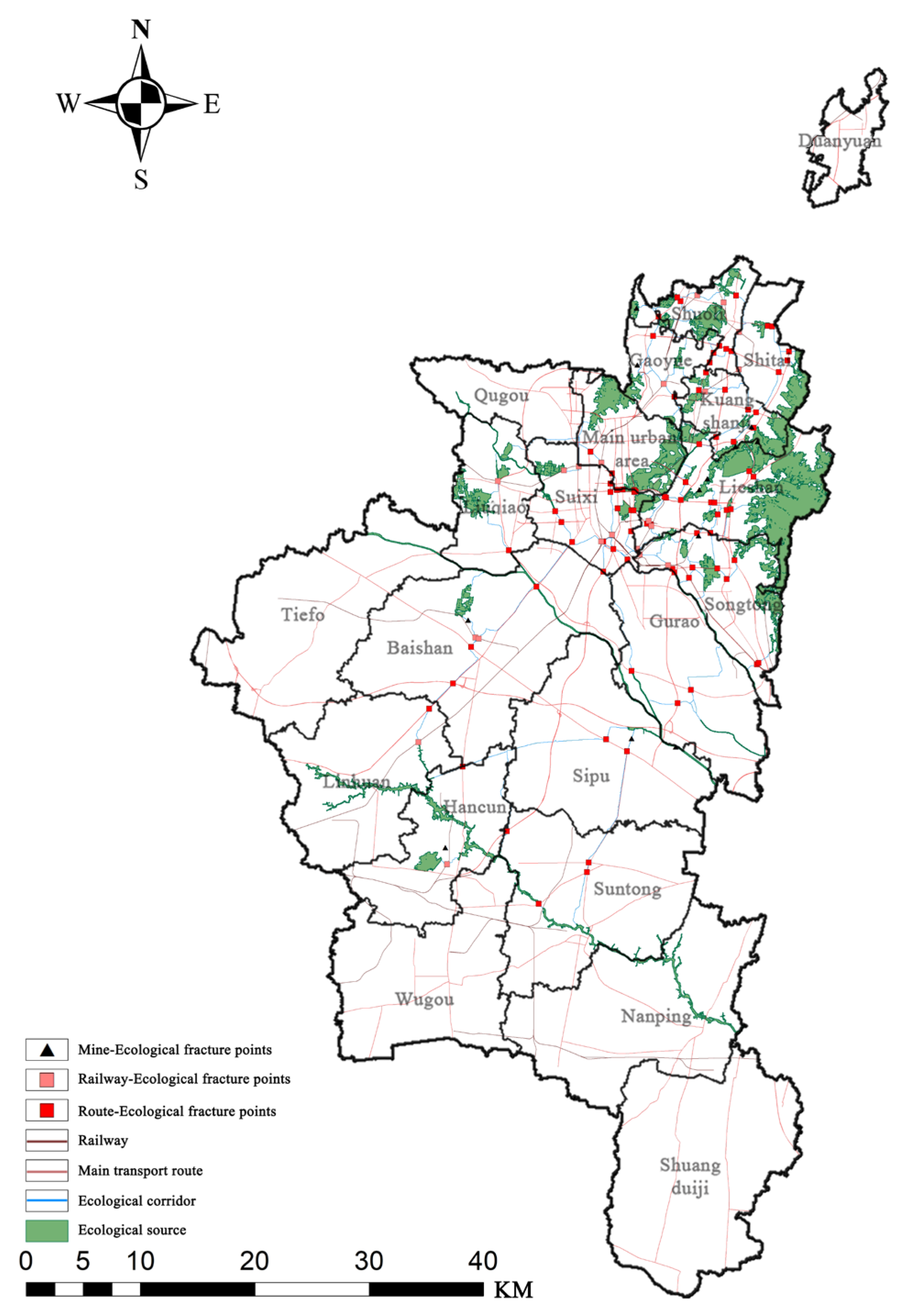
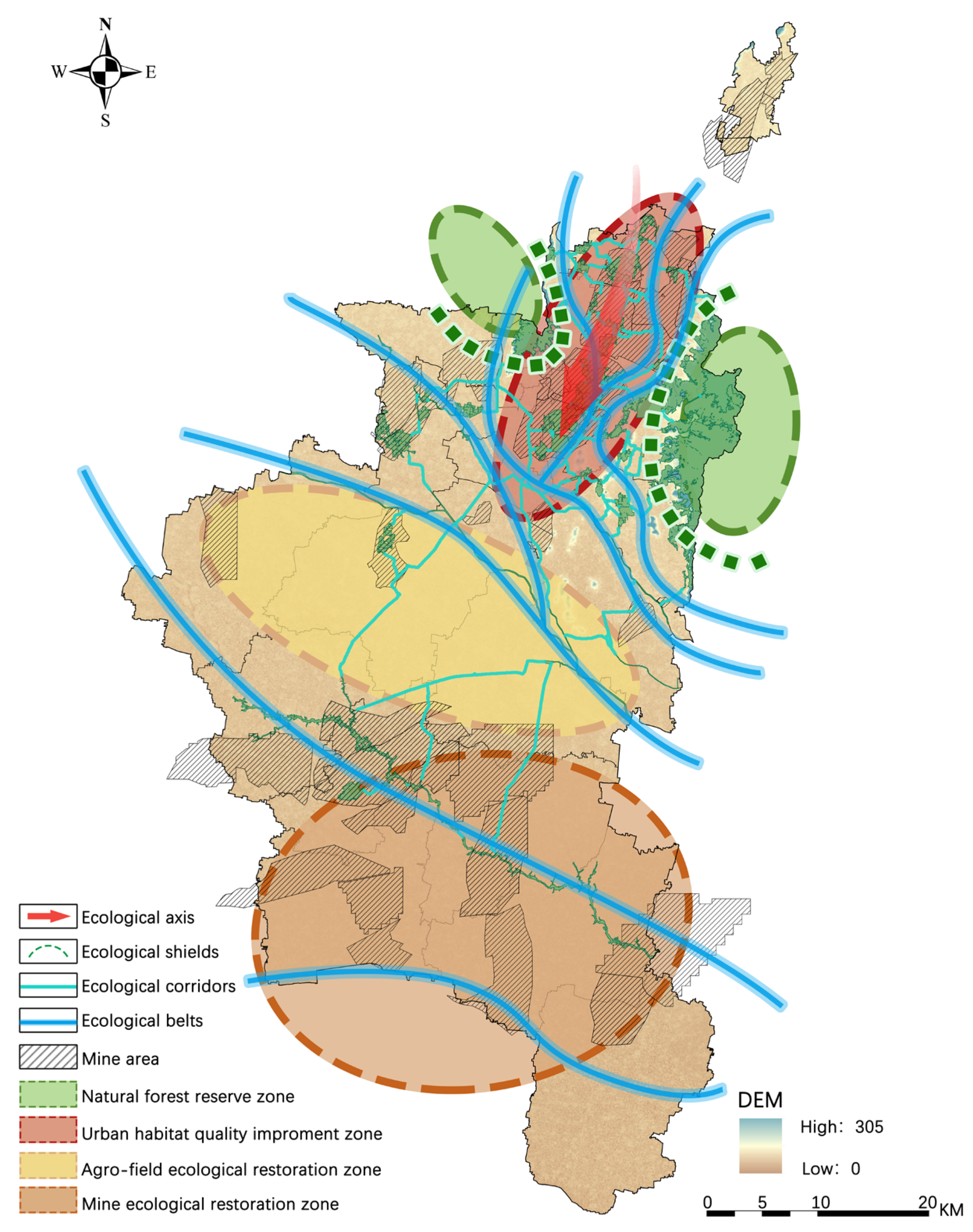
| Ecosystem Structure | Method | Formula and Variable Description |
|---|---|---|
| Probability of connectivity (dPC) | Conefor2.6 | : the patch importance for maintaining the overall probability of connectivity; : the value of after removing a specific patch. The distance threshold was set to 5000 m, and the probability of connectivity was set to 0.5 |
| Integral index of connectivity(dIIC) | Conefor2.6 | : the patch importance for maintaining the integral index of connectivity; : the value of after removing a specific patch. The distance threshold was set to 5000 m, and the probability of connectivity was set to 0.5 |
| Shannon Diversity Index (SHDI) | Fragstats4.2 | : Shannon Diversity Index; : the total land-use type; : the proportion of type i in the total type. The moving window search radius was set to 100 m |
| Shannon evenness index (SHEI) | Fragstats4.2 | : Shannon evenness index; : the total land-use type. The moving window search radius was set to 100 m |
| Correct Indexes | Formula | Variable Description |
|---|---|---|
| The degree of coal mining subsidence impact | : ecological resistance values revised by the impact of coal mining subsidence; : the value of impact of mining subsidence of raster ; : the average value of mining subsidence impact for raster i corresponding to land use type a | |
| Intensity of economic activities | : ecological resistance revised by nightlight index; : the value of nightlight index of raster ; : the average value of mining nightlight index for raster i corresponding to land use type a |
| Districts | Number | Area (km2) | Location | Land-Use Type |
|---|---|---|---|---|
| Xiangshan District | 1 | 0.20 | 1. The connection of Xiangshan Forest Park with the Xiaosuixin River | Forest land Grassland |
| Lieshan District | 7 | 1.28 | 1. The Longdai River (east of South Lake, south of Shuoyong Road) | Water |
| 2. Confluence of Ji Ditch and the Zha River | ||||
| 3. The Wangyin River (the section from Xiaohuai Road to S101) | ||||
| 4. Pa River—Qiujia Ditch—Changfu Canal (confluence of the Xiao Xiaosuixin River and the Zhahe River) | ||||
| 5. The Ditch connecting the Hongjian River to the Wangyin River | ||||
| 6. Confluence of the Laosui River and Xiaosuixin River | ||||
| 7. The Old Sui River (the middle section between Qianlong Lake and Nan Lake) | ||||
| Duji District | 3 | 0.53 | 1. The Dai River (the section from Huaihaidong Road to Lianxin Avenue) | Water Cultivated land |
| 2. The Dai River (the section of Pangshan Village) | ||||
| 3. The connection between the Longdai River and the Zha River | ||||
| Suixi County | 6 | 1.70 | 1. The Ditch connecting the Hongjian River to the Wangyin River | Water Cultivated land |
| 2. Suilin Ditch (confluence of the Nantuo River and Xiaosuixin River) | ||||
| 3. The Zhi River (the section from Baiyang Road to Suiyong Road) | ||||
| 4. Wangyin Ditch (the middle section of Cao Ditch and Pa River) | ||||
| 5. The Jiehongxin River (the middle section of the Suiti Ditch and Yanming Ditch) | ||||
| 6. The connection between Linhuan Lake with the Kuai River |
| Districts | Number | Area (km2) | Location | Land-Use Type |
|---|---|---|---|---|
| Xiangshan District | 2 | 0.70 | Southern Qugou Town; Adjacent to Qugou Town and Suixi Town | Construction land Cultivated land Rural settlements Mining land Grassland |
| Lieshan District | 27 | 4.36 | Southern Gurao Town; Southwestern Lieshan Town | Construction land Cultivated land Mining land Water |
| Duji District | 34 | 8.47 | Mid-Southern Shuoli Town; The central portion of Gaoyue Street; Southern Shitai Town; Western Kuangshanji Town | Construction land Rural settlements Cultivated land Mining land |
| Suixi County | 12 | 2.84 | Mid-Northern Liuqiao Town; Northern and Eastern Suixi Town; The central portion of Sipu Town | Rural settlements Cultivated land Water |
| Types | Number | Location |
|---|---|---|
| Route-Ecological fracture points | 84 | Northwestern and southern Shuoli Town; Eastern Shitai Town; the central portion of Kuangshanji Town; Western Lieshan Town; Eastern Suixi Town; the central portion of Songtong Town; the central portion of Baishan Town; Southern Gurao Town; the central portion of Sipu town; the central portion of Suntong Town |
| Railway-Ecological fracture points | 21 | The central portion of Shuoli Town; the central portion of Gaoyue Street; Western Kuangshanji Town; Northern and southern Suixi Town; Western Lieshan Town; Western Gurao Town; the central portion of Liuqiao Town; the central portion of Baishan Town; Northeastern Linhuan Town; the central portion of Hancun Town |
| Mine Ecological fracture points | 12 | The western part of Shuoli Town; the western part of Gaoyue Street; the western part of Lishan Town; the southeastern part of Kuangshanji Town; the northern part of Songtong Town; the northeastern part of Sipu Town; the central portion of Hancun Town. |
| Types | Location Ranges | Characteristics |
|---|---|---|
| Natural mountain-forest ecological protection zone | Area east of the East Outer Ring Road; Xiang Shan Forest Park | 1. Forested ecological source lands are the main component; 2. As an important ecological green space in the region, providing ecosystem services such as water conservation and carbon sequestration. |
| Urban ecological quality improvement zone | Shuoli Town; Shitai Town, Qugou Town, Central urban area, Suixi County; Liuqiao Town | 1. Major concentration of production and life with high population density; 2. Insufficient connectivity of ecological sources of lakes and low quality of landscape infrastructure. |
| Agricultural field ecological improvement zone | Qugou Town, Songtong Town, Gurao Town, Tiefo Town, Baisan Town, Sipu Town, Nanping Town, Shuangdui Town | 1. Concentrated areas of arable land, less affected by coal mining; 2. Problems of pollution from agricultural production and soil erosion; 3. Low grade of ecosystem services function and lack of important ecological patches. |
| Mine ecological restoration zone | Liuqiao Town, Linhuan Town, Hancun Town, Wugou Town, Suntong Town, Nanping Town | 1. Some coal mines are still in production; 2. Coal mining subsidences have not been stabilized; 3. Complex ecological problems and lack of ecological sources. |
Disclaimer/Publisher’s Note: The statements, opinions and data contained in all publications are solely those of the individual author(s) and contributor(s) and not of MDPI and/or the editor(s). MDPI and/or the editor(s) disclaim responsibility for any injury to people or property resulting from any ideas, methods, instructions or products referred to in the content. |
© 2023 by the authors. Licensee MDPI, Basel, Switzerland. This article is an open access article distributed under the terms and conditions of the Creative Commons Attribution (CC BY) license (https://creativecommons.org/licenses/by/4.0/).
Share and Cite
Li, Z.; Chang, J.; Li, C.; Gu, S. Ecological Restoration and Protection of National Land Space in Coal Resource-Based Cities from the Perspective of Ecological Security Pattern: A Case Study in Huaibei City, China. Land 2023, 12, 442. https://doi.org/10.3390/land12020442
Li Z, Chang J, Li C, Gu S. Ecological Restoration and Protection of National Land Space in Coal Resource-Based Cities from the Perspective of Ecological Security Pattern: A Case Study in Huaibei City, China. Land. 2023; 12(2):442. https://doi.org/10.3390/land12020442
Chicago/Turabian StyleLi, Zixuan, Jiang Chang, Cheng Li, and Sihao Gu. 2023. "Ecological Restoration and Protection of National Land Space in Coal Resource-Based Cities from the Perspective of Ecological Security Pattern: A Case Study in Huaibei City, China" Land 12, no. 2: 442. https://doi.org/10.3390/land12020442
APA StyleLi, Z., Chang, J., Li, C., & Gu, S. (2023). Ecological Restoration and Protection of National Land Space in Coal Resource-Based Cities from the Perspective of Ecological Security Pattern: A Case Study in Huaibei City, China. Land, 12(2), 442. https://doi.org/10.3390/land12020442






